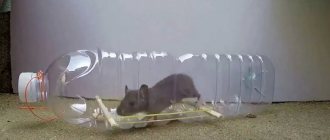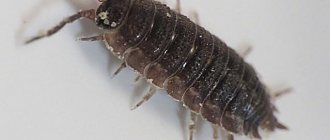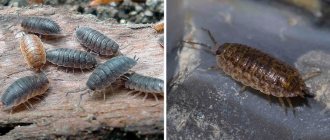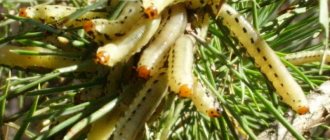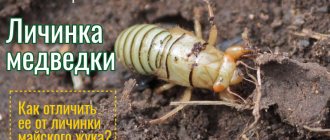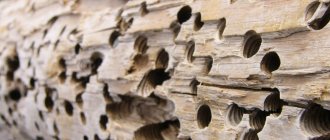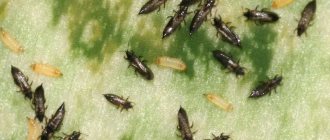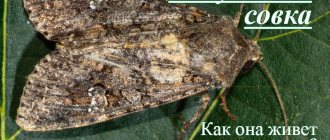The click beetle or wireworm poses a serious threat to gardens and vegetable gardens. The pest prefers acidified soil, high humidity, and dense thickets of wheatgrass. In other words, this pest is omnivorous, so it can cause irreparable damage to future crops. If the wireworm is not dealt with, the area can turn into a real colony of these pests, where you can find parasites of different ages.
The article talks about what the pest looks like and how to deal with it. The main attention is paid to preventing the appearance of click beetles in the garden.
Click beetle and its wireworm larva: photo
In the photo: click beetle and wireworm.
Description of the beetle
The beetle got its name due to its unique ability to turn over from its back to its abdomen using a jumping mechanism. At the same time, a sound similar to a click is heard.
The body of the click beetle is oblong, from 10 to 60 mm in length, black or brown. Click beetles living in the tropics have more varied colors. Their body is:
Click beetle.
- yellow;
- orange;
- red;
- green with a metallic tint or silvery hairs.
Some species may have stripes or spots on their elytra.
In Central America, there are species of click beetles with a bioluminescent glow.
Two light organs are located at the corners of the pronotum, and one in the middle of the first abdominal sternite, and they are visible during flight. Females thus attract mates. Also, some wireworms have bioluminescence, which they use to attract food.
Varieties of click beetles.
Characteristics of the larva
Wireworm larva.
Due to a decrease in the number of soil treatments and a reduction in crop rotation, the number of wireworm pests has increased. The larva of the click beetle, or wireworm, has a body consisting of 13 segments, cylindrical, with a dense chitinous cover, naked, and in rare cases covered with hairs.
The body color of the wireworm ranges from light yellow to dark brown. Its length is up to 30 mm. The pupa is white, beige or yellowish in color. The larva eats the seeds and, as it matures, the root system of the seedlings.
Spreading
There are about 10,000 species of click beetles in the world. They live all over the planet, but they do not survive in Antarctica. In the tropics, these insects are larger and more varied in color.
Adult beetles live on the surface, they sit on grass, trees, in cracks, on stones.
The larvae develop in the soil, in rotten trees, in plant tubers, and sometimes in rotten wood.
How to make traps
Amateur gardeners came up with such a trap for a malicious pest. Take a liter plastic bottle. The neck with a small part of the body is cut off. A stopper is not needed. The inverted neck is inserted into the lower part of the bottle, where a little beer was previously poured (for the smell). To prevent large and beneficial insects and small frogs from falling into the trap, a stopper nail should be inserted immediately under the neck. Wireworms will freely crawl under the nail into the neck and plop down into the bottom of the bottle, right into the beer, and they won’t be able to get out of there. Several similar traps can be placed at some distance from each other, sprinkled lightly with earth. To prevent the beer from leaking out, it is recommended to lift the trap at a slight angle.
You will learn more about click beetles from the video:
Chemists synthesized female pheromones. This substance attracts males for reproduction. A capsule with a pheromone is placed on a sticky trap, where the males are caught. Thus, the fertility of beetles in the area decreases, and accordingly, the laying of eggs and the appearance of larvae decreases.
Reproduction and nutrition
As soon as warm days arrive in the spring, female click beetles fly out and begin laying eggs . Their favorite places for laying are thickets of wheatgrass, burdocks, roots and stems of weeds. If there is no suitable vegetation, they may lay eggs in cracks in the ground or under clumps of soil. They especially love land plots where root crops are planted.
Eggs
The life cycle from egg to adult beetle lasts 4-5 years. The female lays an average of 120-150 eggs. They are white and small. There are from 5 to 15 eggs in one clutch.
Larva
The larvae appear within a month, and they grow and develop for several years. In the first year of life, the click beetle larva feeds mainly on plant roots and weed leaves. But in the second year, wireworms settle in potato tubers, carrots, beets, and radishes. They eat seeds and sprouts of cereals. And only after four years they pupate and in the spring adult beetles appear on the surface.
Adults
Beetles feed on leaves, but carnivorous species of click beetles are also found. Adult beetles of some species do not feed at all; they live off the reserves that they accumulated while in the larval stage.
What does an insect eat?
Adults do not eat anything or feed on the juices of green parts of plants. They don't cause much harm. The real destroyers of agricultural crops are the larvae. The thin, strong structure of the body allows them to easily pierce the skin of root crops and roots.
There are about 750 species of cracker beetles in our area. The diet of each of them is slightly different.
- Wireworms of turfgrass and black click beetle prefer potato tubers and vegetable crops.
- The larvae of shiny, striped beetles eat cereals and sunflowers.
- The small click beetle eats peanuts, beets, carrots, and grain crops.
- The steppe wireworm damages almost all crops.
On a note!
Insects do not disdain weeds. They eat leeks and burdock with great appetite. If proper measures are not taken, pests will completely destroy the entire crop and all the vegetation on the site.
Beetle development cycle
Why is the click beetle
Nutcracker.
The jumping mechanism is a small thoracic process. It is located between the prothorax and mesothorax; if the beetle falls on its back, it is triggered and turns it over in the air back onto its abdomen, and a click is heard. From any position, the clicker turns over onto its paws.
Also, when the beetle is rejected, when emerging from the pupa, or when escaping from danger, the beetle uses its jumping mechanism.
Tselinnik, Strigun, Kravchik
Large beetles, reaching 3.5 cm in length, prefer to live on untouched lands, but with the development of agriculture and human occupation, more and more land areas are settling in the vicinity of cultivated areas, which makes it easier for them to find food.
The head is flattened, large with a straight line connecting the forehead and clypeus, with a pair of cheek protrusions located at the edges of the eyes.
In front of the eyes there is a pair of hard antennae, at the ends of which there are brush-like thickenings. Males have fang-shaped hard processes on the jaw, which males use to win the right to mate. The mandibles, covered with short hairs, are hidden between the biting fangs. In females, the jaw processes are smoothly rounded and have no fangs. Gardeners are annoyed by ants, Colorado potato beetles, mole crickets, May beetles, bugs, leafhoppers, wasps, cutworms, and locusts.
The body of the beetle is massive, the elongated head part smoothly passes into a powerful wide chest and ends with a rounded abdomen. In general, the beetle's body looks convex, as if covered in a shell. The color can be matte black or black with a blue sheen in the sun.
The Strigun has three pairs of tenacious and strong limbs, which are covered with stiff hairs, and there are claws at the ends of the paws.
The wings are not developed, this species does not fly, it has hard and short, fused elytra.
Did you know? Beetles are the most numerous family of insects, making up about 40% of all available individuals. Entomologists believe that there are more than five million species of beetles, although only 350 thousand have been studied to date.
Signs of wireworms appearing on potatoes
In addition to tubers, the larvae can eat roots and tops. The appearance of a pest can be judged by:
- withered potato bushes. Pests move in the soil at a depth of 1 to 2 m. They can move no more than 20 cm from the tubers;
Potatoes affected by wireworm.
- the presence in young tubers of through narrow holes and dark depressions on the peel - these are places for the movement of larvae. Early digging of potatoes will help detect the pest;
- movement of parasites in the upper layer of soil (at a level of 5-10 cm). This usually happens when loosening or digging.
Chemicals
You can try to destroy the wireworm using poison, but the main disadvantage of the method is toxicity. Experts recommend first of all trying all natural remedies to expel the pest and only as a last resort resorting to the use of chemical preparations for wireworms. Gentle control options include feeding with fertilizers containing ammonium. Effective methods include watering the soil before sowing with a solution of potassium permanganate in a 1:2 ratio.
In the event of an insect invasion, 100% success in getting rid of it is achieved by adding Bazudin. Diazonin in its composition is a lethal weapon against the beetle and is highly toxic to humans and the environment. The list of drugs against the Nutcracker bug is headed by the insecticide Prestige. It destroys up to 70% of wireworms. Use is permissible on late and mid-late crops, otherwise there is a high risk to human health. For prevention purposes, it is recommended to treat potato tubers with the drug before planting.
Harm and methods of control
The larvae cause particular harm, and control methods are aimed at destroying them. Wireworms make holes in roots and root crops. They spoil the seeds and thin out the seedlings.
Even one beetle can cause a large colony to appear.
Planting
Properly organized crop rotation will significantly reduce the number of wireworms on the site. The same applies to neighbors, who will repel the pest with their smell. Planted:
- Dahlias. The pest cannot tolerate the smell of the plant.
- Green manure. Mustard, rapeseed, buckwheat and sweet clover release essential oils into the soil that repel click beetles and wireworms.
- Bobovykh. These crops, especially peas and beans, repel insects.
Efficient cleaning
Keeping the site clean is the key to preserving the integrity of the entire crop. When there is a wireworm threat, it is necessary to especially pay attention to some points.
Harvesting tubers and roots . If you completely clean the area in the fall, then the pests will have nothing to eat.
Weed elimination . Nests are most often found in thickets of burdock and wheatgrass. Their cleaning is complete prevention.
Attracting allies
Natural enemies of wireworms will help reduce the population and even completely destroy them. One of these is the garden ground beetle - the larva of which is similar to the larva of a wireworm. Birds will also help :
- wagtails;
- starlings;
- turtle doves;
- rooks;
- blackbirds;
- woodpeckers.
Traditional methods
| Eggshell | One of the cheapest and most versatile products. It is crushed and processed into tubers before planting. Typically, eggshells are placed in a hole or scattered over the beds. |
| Nettle or dandelion | 0.2 kg of dandelion or 0.5 kg of nettle is added to a bucket of water. The resulting mixture is used to treat each hole before planting. This treatment begins 7 days before planting with an interval of every 2 days. |
| Ammonium nitrate | Ammonia repels pests, forcing them to go very deep into the soil. 20-30 grams is enough for 1 square. meters. |
| Potassium permanganate | 3 grams are diluted in a bucket of water and filled in the holes before planting. Treating adult bushes with this solution will also be beneficial. |
A proven and safe folk method is mustard. The rules for its use are in the article.
Traps
Traps will help collect more wireworm larvae in one place and destroy them. There are several effective baits.
- Potato. The tuber, possibly spoiled, is soaked in water for a day, then buried in the ground. There are several such traps made. After just 2 days, you can dig up and destroy the tubers; they will be completely riddled with larvae.
Trap in a jar.
- Pieces of potatoes or carrots in a jar . You need to put a few pieces and dig the container up to the neck, and cover the top with cardboard. In a few days, most of the wireworms in the area will gather there.
- Cereals . Two weeks before the main planting, it is necessary to sow several holes in the area with barley and wheat. Young sprouts will attract hungry pests. They are dug up and burned.
Chemicals
Potato treatments with various chemicals are effective. But their use needs to be controlled. Early varieties cannot be treated with chemicals ; they accumulate substances and do not have time to remove them. For others, the following are suitable:
- Prestige;
- Cruiser;
- Commander;
- Taboo.
Detailed instructions for treating potatoes from wireworms can be found here.
Preventive recommendations
A number of useful recommendations from specialists and experienced gardeners will help prevent the appearance of many pests on the site, including wireworms.
What to do:
- Timely removal of weeds will help in the fight against many pests.
- It is advisable to follow the rules of crop rotation so as not to plant the same crop in one place.
- In autumn and spring, it is better to dig deep into the soil on the site.
- It is better to plant leguminous plants interspersed in potato beds.
- An integrated approach to the fight against wireworms will help achieve a positive result.
Inaction on a personal plot or summer cottage in terms of pest control can lead to complete loss of the crop. If someone has a negative attitude towards toxic substances, then at least with the help of simple traps, it is still worth fighting pests. In addition, good results can be obtained if you use a number of agrotechnical measures. Mandatory planting of crops on the site that are not included in the wireworm’s diet also bears fruit. So, a little bit of each method and we can already say that pests are unlikely to feel comfortable on the site.
The wireworm is a click beetle. Description, control measures.


